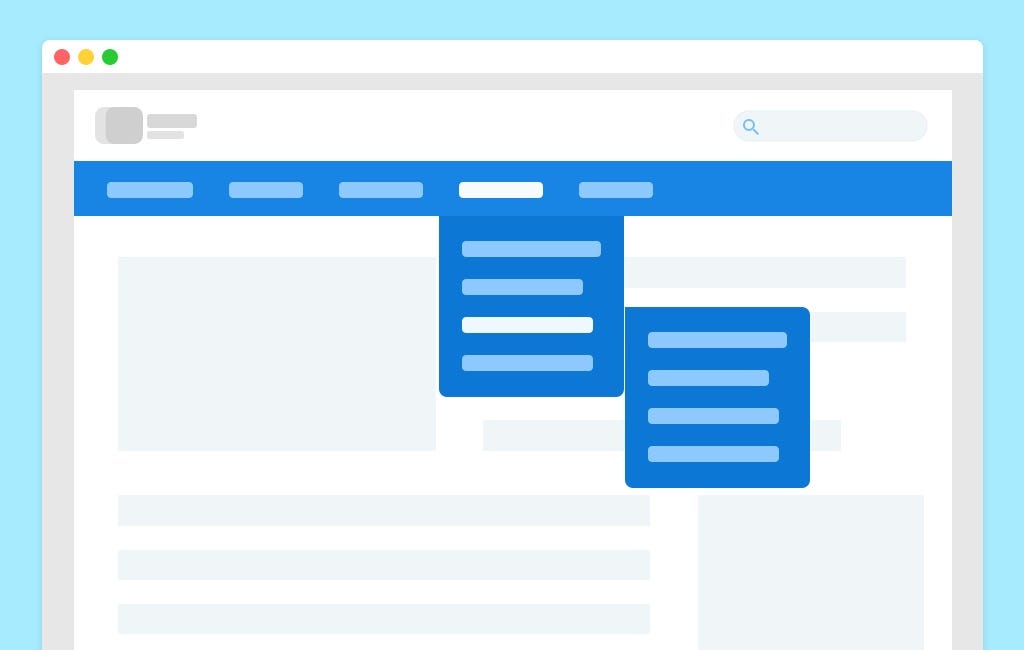Want to know more about the importance of good website navigation? As more and more businesses move their operations online, the importance of having a user-friendly website cannot be overstated. One of the most important aspects of website design is navigation. Good website navigation can make or break the user experience, as it ensures that visitors can easily find what they are looking for on your website. In this article, we will explore the importance of good website navigation and provide actionable tips to improve your website’s navigation.
What is Website Navigation?
Website navigation refers to the system that allows visitors to move around a website and access the content they are looking for. Navigation can take many forms, including menus, buttons, links, and search bars. The goal of website navigation is to help visitors find the information they need quickly and easily.
Why Good Navigation is Important?
Good website navigation is important for several reasons. Firstly, it improves the user experience. Visitors to your website are more likely to stay longer and engage with your content if they can find what they are looking for easily. Secondly, good navigation can lead to increased conversions. If visitors can find the products or services they are interested in quickly, they are more likely to make a purchase or take the desired action. Finally, good navigation can improve your website’s search engine optimization (SEO) by making it easier for search engine crawlers to navigate and index your site.
Types of Website Navigation
There are several types of website navigation, including:
Global Navigation
Global navigation refers to the main menu that appears on every page of your website. This menu typically includes links to the most important sections of your website, such as your home page, about page, contact page, and product or service pages.
Local Navigation
Local navigation refers to menus or links that appear on specific pages of your website. For example, if you have a blog, you might include a menu that allows visitors to filter blog posts by category or date.
Hamburger Navigation
Hamburger navigation refers to the three horizontal lines that are commonly used to indicate a menu on mobile devices. When clicked, the hamburger icon reveals a menu that visitors can use to navigate the website.
Footer Navigation
Footer navigation refers to the menu or links that appear in the footer of your website. This menu typically includes links to important pages such as your privacy policy, terms of service, and copyright information.
Elements of Good Website Navigation
To ensure that your website’s navigation is effective, it should include the following elements:
Simplicity
Good website navigation should be simple and easy to use. Visitors should be able to find what they are looking for with just a few clicks.
Consistency
Consistent navigation throughout your website ensures that visitors know how to move around and find what they are looking for, no matter what page they are on.
Clarity
Navigation labels should be clear and easy to understand. Visitors should know exactly what to expect when they click on a link.
Accessibility
Navigation should be accessible to all visitors, including those using assistive technologies such as screen readers.
Tips for Effective Website Navigation
Here are some tips to improve your website’s navigation:
Keep it Simple
Use clear, concise labels for your navigation links, and limit the number of links to only the most important pages.
Use Dropdown Menus Sparingly
While dropdown menus can be useful for organizing content, they can also be overwhelming for visitors if they contain too many options. Use them sparingly and make sure they are easy to navigate.
Prioritize Important Pages
Place links to your most important pages in a prominent location, such as the main menu or header.
Use Descriptive Link Text
Use descriptive link text that accurately describes the content on the linked page.
Provide Search Functionality
Include a search bar on your website to make it easy for visitors to find what they are looking for.
Optimize for Mobile Devices
Make sure your website’s navigation is optimized for mobile devices, including using responsive design and hamburger navigation.
Use Breadcrumbs
Breadcrumbs are a type of navigation that displays the path a visitor has taken to get to the current page. They can help visitors understand the structure of your website and make it easier to navigate.
Common Navigation Mistakes to Avoid
Here are some common navigation mistakes that you should avoid:
Using Unfamiliar Icons
Icons can be a useful addition to your website’s navigation, but make sure they are clear and recognizable to visitors.
Using Non-Intuitive Labels
Avoid using non-intuitive labels for your navigation links. For example, “Products” is a more intuitive label than “Solutions.”
Using Too Many Levels
Using too many levels of navigation can make your website confusing and difficult to navigate. Stick to two or three levels at most.
Overusing Dropdown Menus
As mentioned earlier, dropdown menus can be overwhelming for visitors if they contain too many options.
How to Test Website Navigation
Testing your website’s navigation is an important part of ensuring that it is effective. Here are some methods you can use to test your website’s navigation:
Usability Testing
Usability testing involves observing visitors as they use your website and identifying any issues or problems they encounter.
A/B Testing
A/B testing involves testing two versions of your website’s navigation to see which one is more effective.
Heat Mapping
Heat mapping involves using software to track visitors’ clicks and movements on your website. This can help you identify which areas of your website are getting the most attention.
Improving Website Navigation for SEO
Good website navigation can also have a positive impact on your website’s search engine optimization (SEO). Here are some tips for improving your website’s navigation for SEO:
Use Text Links
Using text links for your navigation can help search engine crawlers understand the content on your website.
Use Keywords in Navigation Labels
Including keywords in your navigation labels can help search engines understand the content on your website and improve your rankings for those keywords.
Use Breadcrumbs
As mentioned earlier, breadcrumbs can help search engine crawlers understand the structure of your website and improve your rankings.
The Impact of Responsive Design on Website Navigation
Responsive design is an approach to web design that allows a website to adapt to different screen sizes and devices. The use of responsive design can have a significant impact on your website’s navigation, as it allows you to optimize your navigation for different devices. For example, you might use hamburger navigation for mobile devices and a full menu for desktop devices.
Conclusion
Good website navigation is essential for creating a positive user experience and driving conversions. By following the tips and best practices outlined in this article, you can improve your website’s navigation and make it easier for visitors to find what they are looking for. Remember to test your website’s navigation regularly and make adjustments as needed.
FAQs
Q1: What is the best type of navigation for a website?
A1: The best type of navigation depends on the specific needs of your website and your visitors. However, global navigation and search bars are generally considered to be the most important types of navigation.
Q1: How many links should I include in my website navigation?
A2: It’s generally best to keep your navigation simple and limit the number of links to only the most important pages. A good rule of thumb is to have no more than seven links in your main menu.
Q3: Can I use images for website navigation?
A3: While images can be visually appealing, it’s generally best to use text links for your navigation to ensure that it is accessible to all visitors, including those using assistive technologies.
Q4: How often should I test my website’s navigation?
A4: It’s a good idea to test your website’s navigation regularly, especially after making any significant changes to your website.
Q5: How can I optimize my website’s navigation for SEO?
A5: You can optimize your website’s navigation for SEO by using text links, including keywords in your navigation labels, and using breadcrumbs to help search engine crawlers understand the structure of your website.





